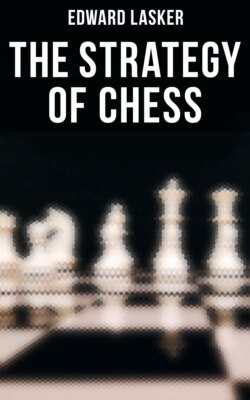Читать книгу The Strategy of Chess - Edward Lasker - Страница 24
На сайте Литреса книга снята с продажи.
11. P-KR3
ОглавлениеOne of the few instances in which this pawn move is justified.
It deprives Black's QB of its only good square, and saves the
KKt, the co-operation of which is urgently needed in the centre.
This system of opening will receive more exhaustive treatment under the heading of "Middle Game." (Compare Game No. 12.)
In the second main line of defence, of which I shall treat now, Black renounces the maintenance of his KP, and makes an attempt to find compensation by attacking White's King's Pawn. The King's file, opened by the disappearance of the Black pawn, offers opportunities for that purpose. After the first few moves we arrive at the following position, which
———————————————————
8 | #R | | | #Q | | #R | #K | |
|———————————————————|
7 | #P | #P | #P | #B | #B | #P | #P | #P |
|———————————————————|
6 | | |#Kt | #P | |#Kt | | |
|———————————————————|
5 | | ^B | | | | | | |
|———————————————————|
4 | | | |^Kt | ^P | | | |
|———————————————————|
3 | | |^Kt | | | | | |
|———————————————————|
2 | ^P | ^P | ^P | | | ^P | ^P | ^P |
|———————————————————|
1 | ^R | | ^B | ^Q | ^R | | ^K | |
———————————————————
A B C D E F G H
Diag. 24.
may be reached thus: 3. B-Kt5, P-Q3; 4. P-Q4, B-Q2; 5. Kt-B3, Kt- B3; 6. Castles, B-K2; 7. R-K1, PxP; 8. KtxP, Castles. The exchange on the seventh move is compulsory, because the loss of a pawn after BxKt is in effect threatened, now that the White KP is supported by the Rook.
Black's intention of exerting pressure on the KP is now difficult of execution, because his pieces are very cramped and hinder one another in a restricted area. The KB in particular cannot be brought into action without great difficulty, for instance by: R- K1, B-KB1, P-KKt3, and B-Kt2. It is therefore advisable for White to develop his QB at Kt2 instead of at Kt5, in order not to give Black a chance of exchanging his troublesome Bishop. (In a game Bernstein-Emanuel Lasker, Moscow, 1914, there happened 9. BxKt, PxB; 10. B-Kt5, P-KR3; 11. B-R4, Kt-R2; 12. BxB, QxB with a good game for Black.)
The defence has a totally different trend, if Black gives up his own KP, but captures the White KP at once. I have already pointed out that White would not mind his KP being taken, in view of the attack on the open King's file. Let us now consider in which way this attack can be planned. There are two essentially different lines, according to whether Black interpolates P-QR3 or not.
After 3. B-Kt5, Kt-B3; 4. Castles, KtxP; 5. R-K1, Black gets out of it comfortably by playing Kt-Q3, B-K2 and Castles, and White cannot permanently prevent Black's game from being freed by the advance of the QP. P-Q4 for White on the fifth move is therefore stronger. Black cannot very well exchange the pawns, leaving the King's file quite exposed, and must submit to White playing PxP, maintaining the pawn at K5 and preventing Black's P-Q4 for some time to come.
The opening might continue in this way: 5. P-Q4, B-K2; 6. Q-K2,
Kt-Q3; 7. BxKt, KtPxB (to make room for the Kt); 8. PxP, Kt-Kt2
(Diagram 25).
———————————————————
8 | #R | | #B | #Q | #K | | | #R |
|———————————————————|
7 | #P | #Kt| #P | #P | #B | #P | #P | #P |
|———————————————————|
6 | | | #P | | | | | |
|———————————————————|
5 | | | | | ^P | | | |
|———————————————————|
4 | | | | | | | | |
|———————————————————|
3 | | | | | | ^Kt| | |
|———————————————————|
2 | ^P | ^P | ^P | | ^Q | ^P | ^P | ^P |
|———————————————————|
1 | ^R | ^Kt| ^B | | | ^R | ^K | |
———————————————————
A B C D E F G H
Diag. 25
The whole of the manoeuvres now centre round Black's endeavours to force his P-Q4, and White's attempt to prevent it. Black ultimately gains his point, as will be seen, but at the expense of such disadvantages in the pawn position that it is questionable whether the whole variation (called the Rio de Janeiro Defence) is playable.
9. Kt-B3, Castles; 10. R-K1, Kt-B4 (the Knight is to be posted at K3 to bring the White KKt away from his Q4, whence he prevents the advance of Black's QP by attacking QB6); 11. Kt-Q4, Kt-K3; 12. B-K3, KtxKt; 13. BxKt, P-B4; 14. B-K3, P-Q4; 15. PxP e.p., BxP. This is the critical position in the Rio de Janeiro defence. Black has succeeded in eliminating the White centre pawn, and sweeps long diagonals with his Bishops, but the advantage cannot be maintained. White exchanges the Bishop at Q6, and there remains a backward pawn, which Black will hardly be able to hold permanently. In practice it has been shown that the end-game should be won by White in spite of Bishops of opposite colours, as Black's pawn at his QB4 is difficult to defend.
